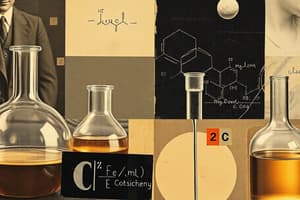Podcast
Questions and Answers
What is the volume of hydrogen produced when 2 g of zinc reacts completely with hydrochloric acid at standard temperature and pressure?
What is the volume of hydrogen produced when 2 g of zinc reacts completely with hydrochloric acid at standard temperature and pressure?
- 0.685 dm3 (correct)
- 0.342 dm3
- 1.224 dm3
- 1.414 dm3
What is the molar mass of potassium trioxochlorate (KClO3) used in the reaction?
What is the molar mass of potassium trioxochlorate (KClO3) used in the reaction?
- 106.5 g/mol
- 100 g/mol
- 122 g/mol (correct)
- 150 g/mol
In the reaction 2KClO3 → 2KCl + 3O2, how many moles of KClO3 are required to produce 1.37 dm3 of oxygen?
In the reaction 2KClO3 → 2KCl + 3O2, how many moles of KClO3 are required to produce 1.37 dm3 of oxygen?
- 0.5 moles (correct)
- 0.75 moles
- 0.25 moles
- 1.0 moles
Which of the following statements regarding the reaction Zn + 2HCl → ZnCl2 + H2 is true?
Which of the following statements regarding the reaction Zn + 2HCl → ZnCl2 + H2 is true?
If the molar volume of a gas is 22.4 dm3, how much volume will be produced when 5.0 g of KClO3 decomposes completely?
If the molar volume of a gas is 22.4 dm3, how much volume will be produced when 5.0 g of KClO3 decomposes completely?
What is the percentage composition of iron in iron (ii) tetraoxosulphate(vi) if Fe = 56, S = 32, and O = 16?
What is the percentage composition of iron in iron (ii) tetraoxosulphate(vi) if Fe = 56, S = 32, and O = 16?
Which formula correctly represents the percentage composition of nitrogen in magnesium trioxonitate(v) where Mg = 24, N = 14, and O = 16?
Which formula correctly represents the percentage composition of nitrogen in magnesium trioxonitate(v) where Mg = 24, N = 14, and O = 16?
What is the percentage of oxygen in ammonium tetraoxosulphate(vi) if N = 14, H = 1, S = 32, and O = 16?
What is the percentage of oxygen in ammonium tetraoxosulphate(vi) if N = 14, H = 1, S = 32, and O = 16?
Calculate the percentage of oxygen in sodium trioxocarbonate (IV) monohydrate where O = 16, Na = 23, C = 12, and H = 1.
Calculate the percentage of oxygen in sodium trioxocarbonate (IV) monohydrate where O = 16, Na = 23, C = 12, and H = 1.
How many moles of a substance are contained in 24 grams of carbon-12?
How many moles of a substance are contained in 24 grams of carbon-12?
What is the total number of particles in 2 moles of a substance?
What is the total number of particles in 2 moles of a substance?
Which reaction type would describe the combination of oxygen gas and hydrogen gas to form water?
Which reaction type would describe the combination of oxygen gas and hydrogen gas to form water?
If the molarity of a solution is defined as moles of solute per liter of solution, what would be the molarity of a solution containing 0.5 moles of sodium chloride in 2 liters of water?
If the molarity of a solution is defined as moles of solute per liter of solution, what would be the molarity of a solution containing 0.5 moles of sodium chloride in 2 liters of water?
What is the number of moles in 20.0g of nitrogen (N2) where the molar mass is 28 g/mol?
What is the number of moles in 20.0g of nitrogen (N2) where the molar mass is 28 g/mol?
How many liters of diatomic oxygen (O2) at standard temperature and pressure (s.t.p.) are needed to obtain 0.50 moles?
How many liters of diatomic oxygen (O2) at standard temperature and pressure (s.t.p.) are needed to obtain 0.50 moles?
What is the concentration in mol/dm³ of a solution containing 2 moles of solute in 500 cm³ of solution?
What is the concentration in mol/dm³ of a solution containing 2 moles of solute in 500 cm³ of solution?
If 1 mole of hydrogen gas reacts with 1 mole of oxygen gas, how many moles of water will be produced?
If 1 mole of hydrogen gas reacts with 1 mole of oxygen gas, how many moles of water will be produced?
What is the molar mass of diatomic chlorine (Cl2)?
What is the molar mass of diatomic chlorine (Cl2)?
Which of the following is NOT a condition for conducting a stoichiometric calculation?
Which of the following is NOT a condition for conducting a stoichiometric calculation?
Which of the following represents the correct relationship for calculating the moles of a gas at standard temperature and pressure (s.t.p.)?
Which of the following represents the correct relationship for calculating the moles of a gas at standard temperature and pressure (s.t.p.)?
If the concentration of a solution is 2 mol/dm³ and its volume is 2dm³, how many moles of solute does it contain?
If the concentration of a solution is 2 mol/dm³ and its volume is 2dm³, how many moles of solute does it contain?
Flashcards are hidden until you start studying
Study Notes
Mole Calculations
- Number of moles (n) can be calculated via different methods:
- n1 = m/M (mass over molar mass)
- n2 = V/Vm (volume over molar volume)
- n3 = N/NA (number of particles over Avogadro's number)
- n4 = CV(cm³)/1000 (conversion from cm³ to moles)
- n5 = CV(dm³) (volume in dm³ directly as moles)
- Molar volume at standard temperature and pressure (s.t.p) is 22.4 dm³ (or 22400 cm³).
- Avogadro's number (NA) is approximately 6.02 x 10²³, representing the number of particles in one mole.
Example Calculations
- Chlorine Mole Calculation: For 10.65g of Cl (Molar mass = 35.5):
- n = 10.65/35.5 = 0.300 moles.
- Oxygen Mole Calculation: For 8.96 dm³ of O₂ (Molar volume = 22.4 dm³):
- n = 8.96/22.4 = 0.400 moles.
- Hydroxide Ions Calculation: For 60.23 x 10²² OH⁻ ions:
- n = 60.23 x 10²²/6.02 x 10²³ = 1.00 mole.
Diatomic Gases Molar Mass
- Hydrogen (H₂): Molar mass = 2 g/mol
- Oxygen (O₂): Molar mass = 32 g/mol
- Nitrogen (N₂): Molar mass = 28 g/mol
- Other diatomic gases include Fluorine (F₂), Bromine (Br₂), Chlorine (Cl₂), and Iodine (I₂).
Writing and Balancing Chemical Equations
- A chemical equation summarizes a chemical reaction's ingredients and outcomes.
- Procedure:
- List reactants on the left, products on the right, separated by an arrow.
- Ensure the number of atoms for each element on both sides is equal.
- Example: Lead (II) oxide can be represented as Pb₃O₄ with a molar mass calculation of 685 g/mol.
Percentage Composition
- Percentage composition formula:
- % Composition = (mass of atom / molar mass of compound) x 100
- Sodium in Sodium Hydroxide (NaOH):
- Molar mass = 40 g/mol, % Na = (23/40) x 100 = 57.5%.
- Water in Magnesium Tetraoxosulphate (VI) Heptahydrate:
- Molar mass = 246 g/mol, mass of water = 126g, % water = (126/246) x 100 = 51.2%.
- Oxygen in Magnesium Tetraoxosulphate (VI):
- Mass of O = 176g, % O = (176/246) x 100 = 71.5%.
Mole Concept
- A mole contains as many elementary units as there are atoms in 12 g of carbon-12, equivalent to Avogadro's number (6.023 x 10²³).
- Reaction example:
- Zn + 2HCl → ZnCl₂ + H₂ with a mole ratio of 1:2:1:1.
Gas Volume Calculations
- The volume of gas can be calculated from moles:
- Example for Zn and H₂: For 0.0306 moles of Zn, producing H₂:
- Volume of H₂ produced = 0.0306 x 22.4 dm³ = 0.685 dm³.
- Example for Zn and H₂: For 0.0306 moles of Zn, producing H₂:
Decomposition of Potassium Trioxochlorate (V)
- Reaction: 2KClO₃ → 2KCl + 3O₂.
- Molar mass of KClO₃ = 122.5 g/mol, meaning 2 moles yield 3 x 22.4 dm³ of O₂.
- For 5g KClO₃:
- Calculated volumes of oxygen = 1.37 dm³ based on proportion.
Practice Problems
- Calculate percentage compositions for:
- Iron in iron (II) tetraoxosulphate (VI).
- Nitrogen in Magnesium trioxonitrate (V).
- Oxygen in ammonium tetraoxosulphate (VI).
- Oxygen in sodium trioxocarbonate (IV) monohydrate.
Studying That Suits You
Use AI to generate personalized quizzes and flashcards to suit your learning preferences.




